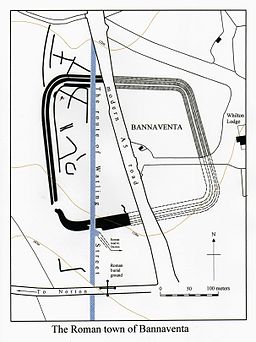Bannaventa
| Bannaventa | |
| Settlement | |
|
Plan of the site of Bannaventa
|
|
| Country | England |
|---|---|
| State | Northamptonshire |
| Region | East of England |
| District | Daventry |
| Municipality | Norton |
| Location | Astride Watling Street (A5) 1 mile northeast of the village of Norton |
 |
|
Bannaventa was a Romano-British fortified town which was situated on the Roman road of Watling Street, which today is known as the A5 trunk road. Bannaventa is 1 mile (1.6 km) northeast of the village of Norton in the English county of Northamptonshire. The Ordnance Survey grid reference for the centre of the town is SP612645.
The road where Bannaventa was located is thought to be the first road constructed by the Romans in Britain. It begins in Portus Ritupis (now Richborough) in the county of Kent and runs in a north westerly direction linking many Roman settlements and towns along its route. At Viroconium (now Wroxeter in Shropshire), the road branched with one route going to Deva Victrix (now Chester) and the other into Wales. Bannaventa was a small fortified town on this road and was 10.9 miles north west of the Roman town of Lactodorum (now Towcester).17.3 miles to the north west was the Roman settlement of Venonis (now Wigston Parva) where Watling street is intersected by the Fosse Way.
Bannaventa is derived from Brittonic *bannā "peak, horn, hill" (cf. Modern Welsh ban, "top, tip, point, summit, crest, peak, beacon, height, pinnacle, turret, hill, mountain, bare hill") and *wentā, of obscure origin, but perhaps "place of sacrifice" or simply "place, field" (as in Welsh cad-went "battle-field")
Mention of the settlement can be found in Emperor Antoninus Pius’s Itinerarium, Iter Britanniarum (The Road Routes of Antoninus Augustus). The extracts are as follows:
...
Wikipedia

